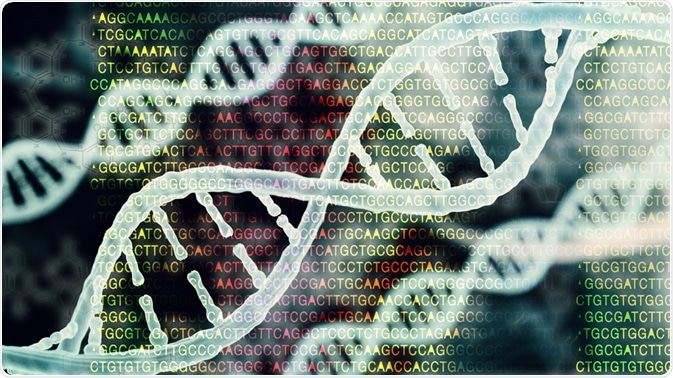Bioinformatics is the application of informatics technique s to obtain, store, and interpret large quantities of biological data. The term “Bioinformatics” was initially coined by Ben Hesper and Paulien Hogewen in 1970 and defined as “the study of informatics processes in biotic systems”. Bioinformatics finds application in different fields of biology, a few of which are enlisted below.

Image Credit: CI Photos/Shutterstock.com
Genomic Sequencing
The study of genomics involves the analysis of genomes, identification of their structure, function, and evolution. In 1990, the Human Genome Project was started with the aim of fully sequencing the human genome via Sanger sequencing. This method created many fragments of DNA that had to be combined using biotechnology processes to create a final complete sequence.
After this project was successfully completed in 2003, the complete genome sequence was comprehensively annotated to include the genes, biological functions of the produced proteins, and their involvement in diseases. Bioinformatics was fundamental to the success of the human genome project as the vast amounts of data produced were analyzed quickly and in a short time that would have otherwise taken a very long time manually.
The data was also published online, which has enabled scientists from all around the world to access it.
With further development in sequencing technologies, an entire genome can now be sequenced in a matter of hours, in a method termed “next-generation sequencing”. This method is an extremely high-throughput, cost-effective, and systematic DNA sequencing technology that allows millions or even billions of DNA strands to be sequenced in parallel as compared to the Sanger method of genome sequencing that uses fragment-cloning methods.
Bioinformatics: A way to deciphere DNA and cure life's deadliest diseases | Spencer Hall | TEDxUGA
Cancer Research
Another major arena that benefits from bioinformatics is cancer research. Cancer bioinformatics is slowly emerging as an important and useful strategy in systems clinical medicine to improve patient outcomes. For instance, Cun and Frolich have reported that interpretation of gene signatures can help stratify breast cancer patients. Huastein and Schumacher have described an algorithm that can stimulate tumor growth and detect metastases in cells.
Cancer bioinformatics is also playing a pivotal role in the identification and validation of network to dynamic network biomarkers. Network biomarkers are new biomarkers that comprise protein-protein interactions. Any alteration to the network biomarkers can be monitored at different time points of disease progression known as dynamic network biomarkers.
These dynamic network biomarkers are further linked to the clinical information of a patient such as disease history and therapy history of the patient, biochemical profiling, imaging, and other measurements. These biomarkers can help in monitoring the disease progression in a patient.
Depending on the disease progression, the existing therapy can either be changed or continued to improve the quality of life of the patient.
Personalized Medication
By identifying individual mutations involved in a disease, personalized medicines can be developed. The genetic information obtained from genome sequencing can help in identifying the precise gene on which the mutation has taken place based on which personalized treatments can be developed.
This can greatly improve the prognosis of an individual. For this, the organizational and analytical aspects of bioinformatics come into play. Lengauer T studied the treatment of HIV patients using bioinformatics-assisted therapy.
In Germany, a pilot study including high-risk pediatric cancer patients called the Individualized Therapy for Relapsed Malignancies in Childhood (INFORM), was carried out with the aim of developing targeted therapy for each patient. Among the 57 patients that were enrolled, 10 received targeted therapy.
The primary relapse analysis demonstrated tumor progression and one case of secondary malignancy indicating the possibility and importance of real-time molecular profiling in such patients to improve individual prognosis.
Evolutionary Biology
The study of evolution involves tracing the origins of the species, identification of their ancestors, and the possibility of any mutations during the evolutionary process. The first genomic sequence, Phage Ф-X174, was identified in 1977. Bioinformatics helps in the comparison of numerous species by their genetic profile and helps in the identification of evolutionary trees called phylogenetic trees.
The huge volumes of data produced are organized well allowing previously undetected genetic events to be characterized, such as identification of horizontal gene transfer.
Protein Structure
Bioinformatics is also used in the analysis of proteins. The structure and function of proteins can be characterized through various high-throughput technologies allowing scientists to gain a greater insight into their roles in the biological processes.
The field of bioinformatics has revolutionized the analysis of data in many areas of biology. It allows us to seek answers for the most important and fundamental biological questions without the burden of accumulating large volumes of data.
Further Reading